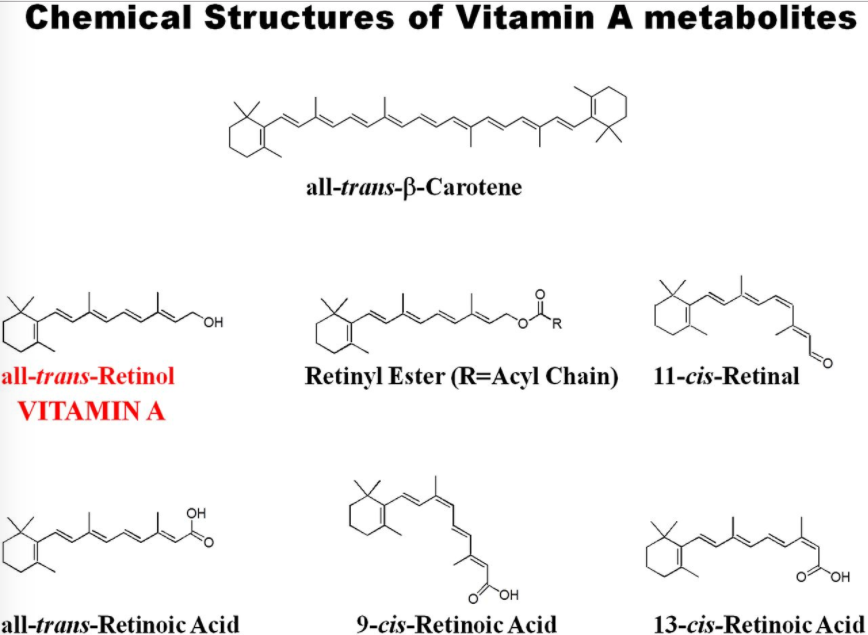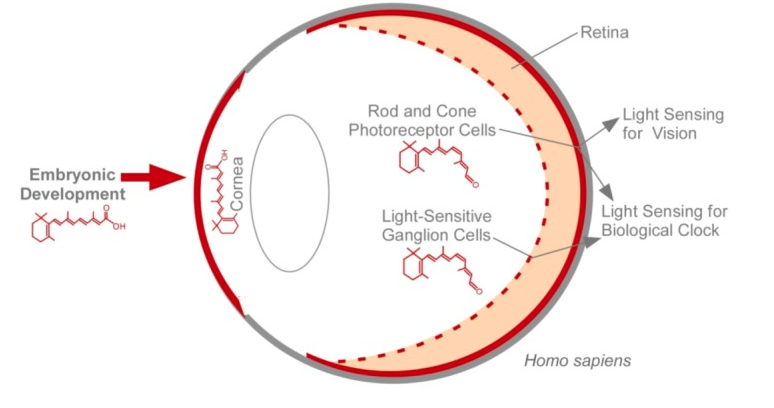Vitamin A is fundamental for healthy vision.
![Vitamin A. By Sergiy O. Bukreyev [Public domain], via Wikimedia Commons](https://supplementsinreview.com/wp-content/uploads/2016/11/Vitamin_A-300x83.png)
- Enhancing light and dark sensitivity. Vitamin A seems to play a major role in photosensitivity and adaptation.
- Combating cataracts and dry eye. Consistent intake of the vitamin may reduce the risk of cataracts, dry eye, and blindness.
- Promoting good vision. The retinol present in vitamin A is key to healthy eye development.
Overview
When grouped together, the compounds retinol, retinoic acid, retinal, and various carotenoids make up the essential vitamin A. The fat-soluble vitamin assists in a plethora of fundamental bodily functions from helping cells multiply (which is essential for maintaining healthy skin and mucous linings as well as for growth) to enhancing the immune system.
It can be derived from two main dietary sources:
- Retinoids. Retinol is found in beef, chicken, eggs, dairy, and numerous other animal products.
- Carotenoids. Countless fruits and vegetables — especially ones colored dark-green. yellow, or orange — carry substantial quantities of carotenoids, notably beta-carotene.
Vitamin A deficiency is a well-known cause of vision problems, such as dry eye (xerophthalmia), age-related macular degeneration (AMD) and impaired night vision, which is why various health advocates consider the vitamin essential for healthy vision.
Currently, its supplemental use has only been proven for treating vitamin A deficiency, although it shows promise in ameliorating eye issues, preventing cataracts, and simply promoting sound vision.
![Carrots are an excellent source of vitamin A. By Kander (Own work) [Public domain], via Wikimedia Commons](https://supplementsinreview.com/wp-content/uploads/2016/11/1024px-Carrots.jpg)
How Vitamin A May Help With Vision
Developing Eye Structures
Vitamin A consists of a solid hodgepodge of chemical structures of which all-trans-retinol seems to be the stand out when it comes to promoting healthy vision. Particularly important for eye pigment formation is 11-cis-retinal.1

Sensing Light & Adapting to Darkness
Inside of the retina, 11-cis-retinal combines with opsin to convert into rhodopsin, which is the vision pigment that enables one to see in low-light. On top of that, the visual pigments that bind to 11-cis-retinol dehydrogenase (cRDH) are purportedly in charge of initiating visual excitation.2
The interplay between vitamin A and eye cells not only activates rhodopsin, which gives eyes the capacity to adapt to darkness3, but also triggers light sensors that are necessary to sense light4 and keep the corneal epithelial cells from drying out or ulcering.
While some of the details have yet to be fleshed out, the necessity of vitamin A in eye development speaks volumes to its significance for healthy vision.

Vitamin A Benefits & Uses for Vision
Vitamin A appears to play a central role in vision formation and maintenance. From as early as embryonic development, vitamin A – in the form of retinal – helps set up the framework of healthy eyes.5 Once all of the organs of the fetus are fully formed, one of the primary roles of retinol is to maintain suitable eye conditions.
Vitamin A seems to help out vision in a bunch of different ways:
- Facilitating visual pigment formation as 11-cis-retinal.6
- Improving light sensitivity.
- Enabling night vision.7
- Improving visual acuity.
- Expediting eye healing, both after eye surgery and injury.
- Reducing the risk of cataracts, dry eye, and developed blindness.8
Counteracts Vitamin A Deficiency
According to research conducted by UNICEF, vitamin A deficiency (VAD) is “the leading cause of preventable childhood blindness.” One of the immediate consequences of low levels of vitamin A is impaired vision because of how critical retinal is in sustaining healthy eyesight.
Missing out on sufficient amounts of vitamin A could lead to serious eye-related issues, such as9:
- Reduced night vision
- Xerophthalmia (dry eyes)
- Xerosis (conjunctiva)
- Bitot’s spots (eye plaques)
- Keratomalacia (damage to the cornea)
- Blindness
The good news is that vitamin A supplements may just be able to turn the tide and replenish depleting supplies in cases of vitamin A deficiency.

Research
Animal Research
Research indicates that vitamin A plays a vital role in maintaining eye function by:
- Recovering visual sensitivity. Supplying vitamin A to retinoid-deprived animals restored rhodopsin levels and enhanced visual sensitivity at a markedly rapid rate.10
- Restoring visual pigment and dark adaptation. Salamander eye rods treated with 11-cis-retinoid solutions promoted the recovery of pigment regeneration and dark adaptation.11
- Sustaining daylight vision. Adding vitamin A to ground squirrel and chicken retinas facilitated the growth of opsin photopigments 20 times faster than in the normal cycle, which is responsible for sustained daylight vision.12
Human Research
Clinical studies collectively highlight the ample potential benefits that vitamin A may offer to vision, from protecting against nuclear cataracts and dry eye to improved night vision and visual acuity.
Vitamin A may protect against nuclear cataracts in older adults.
In this population-based cross-sectional study, 2,900 adults between 49 and 97 years old living in an urban community near Sydney, Australia were given an assortment of nutrients, including vitamin A, and had their eye condition evaluated via lens photography. Vitamin A specifically seemed to reduce the risk of nuclear cataracts.
- The study concluded that “vitamin A, niacin, thiamin, and riboflavin protected against nuclear cataract.”13
Vitamin A (0.05%) eye drops may improve blurred vision, protect tear film, and help handle dry eye
In this randomized and controlled study, 150 patients with dry eye were given either artificial tears, cyclosporine, or vitamin A eye drops 4 times a day for 3 months. Compared to the control, vitamin A led to significant improvement in blurred vision, tear film, and dry eye syndrome.
- The study concluded that “vitamin A eye drops and topical cyclosporine A 0.05% treatments are effective for the treatment of dry eye disorder.”14
Vitamin A at high doses may restore sight in cases of impaired dim-light or night vision
In this single patient case study, a 69-year old male with dry eye and night blindness was given high doses of vitamin A supplements for 1 month. Electroretinograms (ERG) confirmed that scotopic (dim-light vision) function was restored.
- The study concluded that “with high doses of oral vitamin A supplements…the patient reported that his visual function has significantly improved, while repeat ERG testing revealed that scotopic function has improved to normal levels.”15
In this randomized, double-blind investigation, 40 patients who had recently undergone photorefractive keratectomy (eye surgery to correct near-sightedness), were given 25,000 IU retinol palmitate and 230 mg of vitamin E or a placebo 3 times daily for 1 month and 2 times daily for 2 more months thereafter. Vitamin A supplementation resulted in significantly faster re-epithelialization, less haziness, more accurate myopic correction, and significantly better visual acuity.
- The study concluded that “high dose vitamin A and E oral supplementation may accelerate re-epithelialisation time and may reduce corneal haze formation after PRK.”16
Vitamin A may reduce the risk of nuclear cataracts in older adults
In this cross-sectional investigation, 2873 adults between 49 and 97 years were given various vitamins, including vitamin A, over an extended period of time to determine their effect on cataracts. Vitamin A supplements protected against nuclear cataract (odds ratio 0.4).
- The study concluded that use of “vitamin A supplements was associated with reduced prevalence of either nuclear or cortical cataract.”17
Dosage for Vision
Vitamin A may be taken as:
- A supplemental capsule, 900 mcg (~5,000 IU, depending on the form of vitamin A)
- Liquid drops, 5,025 IU
- A topical cream or ointment, 0.025-0.05% retinol
The recommended dose for women is generally smaller (700 mcg) and even lower still for children due to average differences in size and processing.
Supplements in Review Says
- Vitamin A, 900 micrograms or 5,000 International Units
We recommend vitamin A for vision. Vitamin A is widely regarded as an essential component of natural eye development for its abundance of retinol. Its potential benefits include enhancing light sensitivity and adaptation as well as reducing the risk of vision complications, such as cataracts, dry eye, and blindness. Supplementation is highly recommended in cases of vitamin A deficiency.
The ideal way to take vitamin A is as a standardized 900 mcg pill supplement. Sufficient quantities of vitamin A can easily be consumed in the standard diet. Those concerned about vitamin A deficiencies or looking to enhance their vision, may turn to standardized nutrient supplementation to give them the extra stimulus they require.
Leave a Reply